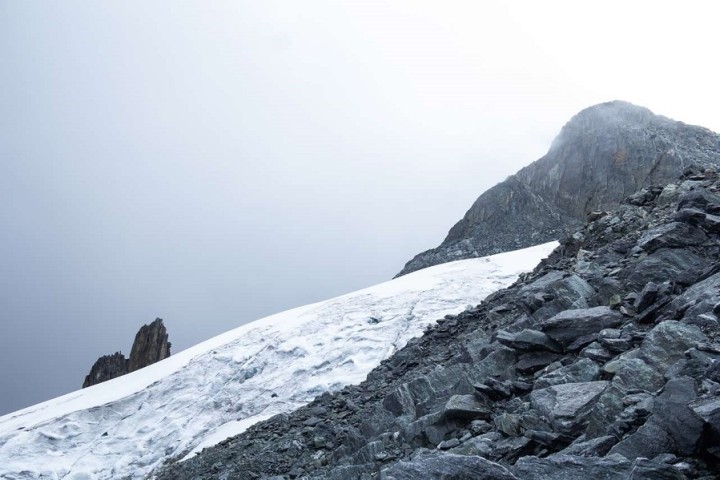The Disappearance of Venezuela's Humboldt Glacier: A Mirror of Global Climate Change

The news of the imminent disappearance of the Humboldt Glacier confronts us with an alarming reality: climate change is reshaping the planet in ways we are still struggling to fully comprehend. This event is not just a geographical loss for Venezuela; it is a reflection of a much larger and more serious environmental crisis affecting the entire globe. The disintegration of this glacier is not an isolated case but part of a global pattern of retreating glaciers, signaling profound changes in Earth's climate systems. This situation underscores the urgency of addressing climate change with more effective policies and international cooperation, as the consequences extend beyond national borders, impacting biodiversity, water resources, and global climate stability. My opinion expressed in this article aims to explore how this phenomenon is not only a harbinger of what might come but also a call to rethink our relationship with the environment and to act decisively to mitigate future impacts.
Humboldt's Last Breath
The Humboldt Glacier, located on Pico Humboldt in the Mérida state of Venezuela, represents a dramatic case of climate change's impact on glaciers. Originally covering 450 hectares, it has now shrunk to barely two hectares, reflecting a 98% decrease between 1952 and 2019. This drastic retreat is part of a broader pattern observed in various regions of the world, such as the Alps, the Himalayas, and the Andes, where climate change is accelerating glacier loss.
Venezuela, which once had six glaciers in the Sierra Nevada de Mérida, has almost completely lost its glacier coverage, positioning it as the first Andean country that could lose all its glaciers. This loss is not just a geographical change but also a significant cultural shift, especially for local communities with historical and spiritual ties to these landscapes.
The rapid decline of the Humboldt Glacier also highlights the challenges in conserving and studying these environments. Although measures have been attempted to preserve what remains of the glacier, such as covering it with thermal blankets, these efforts have largely been ineffective and have raised additional concerns about microplastic pollution.
The situation of the Humboldt Glacier underscores the urgency of adopting stronger global and local measures to address climate change, given its capacity to alter not only natural ecosystems but also water resources and human communities dependent on these fragile environments. Additionally, it emphasizes the importance of scientific research in these fields to better understand the interactions between glaciers and their surroundings and to predict and mitigate future impacts.
This case serves as a reminder that the effects of climate change are immediate and significant, requiring concerted action to mitigate its most devastating impacts on our planet.
Causes and Consequences
The decline of glaciers, primarily driven by rising global temperatures due to the accumulation of greenhouse gases, has far-reaching effects beyond the mere transformation of landscapes. Glaciers are not only spectacular natural monuments but also critical reservoirs of freshwater. These ice masses act as essential water sources during dry seasons and regulate river flows during melting seasons. As glaciers recede, the availability of freshwater can significantly decrease, impacting communities that rely on these resources for drinking water, agriculture, and hydroelectric power generation.
In many parts of the world, such as the Andes, the Himalayas, and the Rocky Mountains, millions of people directly depend on glacier meltwater for their livelihoods. According to the World Resources Institute, approximately 15% of the world's population lives in basins that receive a significant portion of their water from glacier melt, highlighting the critical importance of these habitats for global water security.
In Venezuela, the loss of the Humboldt Glacier symbolizes not only an ecological crisis but also a cultural and identity loss. The glaciers of the Sierra Nevada de Mérida have been a part of the country’s natural heritage and have played a significant role in local culture. The inhabitants of Mérida, for example, have had a long and spiritual relationship with these glaciers, as reflected in various cultural expressions and economic activities such as tourism and mountaineering.
The disappearance of the Humboldt Glacier becomes a clear indicator of the deteriorating environmental health of the region and underscores the urgent need for effective climate change mitigation policies. This loss not only affects the availability of water resources and local biodiversity but also has a profound cultural impact on the communities that have historically been connected to the glacier and its natural surroundings. This phenomenon signals the loss of a critical resource and symbolizes the irreversible transformation of a landscape that once was pristine and a source of inspiration and life for many generations.
The situation of the Humboldt Glacier highlights the intrinsic connection between climate, hydrology, and human culture, and how climate change can fundamentally alter these interconnections, leading to profound and lasting changes in society and the environment.
Global and Local Response
Facing climate change, the global response has been mixed, with effectiveness varying widely. The Paris Agreement has been a significant step towards mitigating climate change effects by setting ambitious goals, such as keeping the global temperature rise well below 2°C and striving not to exceed 1.5°C. The agreement’s structure is based on nationally determined contributions (NDCs), which are voluntary commitments by each country to reduce their greenhouse gas emissions.
Although the agreement has mobilized the international community towards a more unified approach and has intensified the actions and investments needed for a low-carbon future, its success heavily depends on the actual implementation and integrity of these national commitments. Experts suggest that to keep global warming within the limits established by the Paris Agreement, greenhouse gas emissions must peak before 2025 and be reduced by 43% by 2030 compared to 2019 levels.

At the local level, many of the measures adopted have proven to be more symbolic than effective. For example, in Venezuela, attempts to preserve the Humboldt Glacier by covering it with thermal blankets have been criticized for their potential microplastic pollution and ineffectiveness in halting the ice retreat. These efforts highlight the need for more concerted and effective global action that goes beyond symbolic gestures.
The fight against climate change requires a coordinated global effort and credible, ambitious commitments from all countries. Despite advancements in international climate policy with the Paris Agreement, there is still a long way to go to meet climate goals and avoid the worst impacts of climate change in the future.
Final Reflections
The disappearance of the Humboldt Glacier in Venezuela stands as a stark testament to the severity of the climate crisis facing our planet. This is not just a local phenomenon but a visible and alarming indicator of a global problem. Glaciers like Humboldt are sentinels of climate change, and their vanishing reflects the rapid pace at which we are altering Earth's natural systems.
The retreat of glaciers not only transforms the landscape but also has profound implications for biodiversity, water resources, and the lives of millions of people who depend on these systems for their livelihood. The loss of the Humboldt Glacier symbolizes not only a physical change but also a cultural and spiritual loss for the communities that have historically had a deep connection with these landscapes.
This situation highlights the urgent need for more effective policies and stronger international cooperation to address climate change. Current measures, though significant, are still insufficient to halt the trend of global warming and the consequent degradation of our ecosystems. The Paris Agreement is a step in the right direction, but its success will depend on the effective implementation and rigorous adherence to national commitments.
The disappearance of the Humboldt Glacier calls us to rethink our relationship with the environment and to act decisively to mitigate future impacts of climate change. It is a reminder that the effects of our actions are immediate and profound, and that the window to prevent the worst scenarios is closing rapidly.
The climate crisis is part of a broader ecological crisis that challenges our ability to live in balance with nature. We must recognize that our actions have global consequences and that only through a sustained, collective effort can we ensure a viable future for generations to come. The disappearance of the Humboldt Glacier is a call to action, an opportunity to reflect, and a prompt to take the necessary steps to protect our planet.
Rosmel Rodriguez
European Union Climate Pact Ambassador

